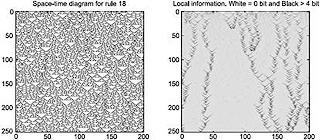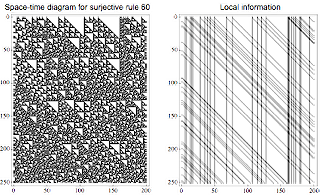One application
of this quantity is as a filtering for common patterns. In the time evolution
of a cellular automaton rule it is often difficult to distinguish the normal
behaviour from more rare events. For example, in a chaotic rule like R18 the
irregular space-time pattern contains local structures that are less common,
but they are not easy to distinguish. Therefore it would be useful to be able
to filter out the regular patterns to identify local configurations that
deviate.
In Figures 1 and 2, the local information is applied to the patterns generated by two cellular automaton rules, one being the irreversible class III rule R18, and the other the almost reversible rule R60. The information pictures reveals a pattern not clearly seen in the space-time CA patterns.
Figure 1. The space-time CA pattern for rule R18, and the
corresponding information density Ii,n picture.
Figure 2. The space-time CA pattern for rule R60, and the
corresponding information density picture. Here the informationdensity Ii,n is derived analytically. A numerical
estimate would not be computationally feasible because of the linearly
increasing correlation lengths.
When the
dynamics is sufficiently reversible, i.e., when the CA rule is surjective, we
have derived the following continuity equation for (left-sided) information for
microscopic dynamics,
![]() ,
,
where JL(i, t) can be interpreted as the information flow from position i–1 to i resulting from the cellular
automaton rule. A corresponding equation for the right-sided quantities can be
similarly introduced. For the surjective rule R60, exemplified in Fig. 6, the
flow is clearly seen. For more examples and details of the formalism, we refer
to [Helvik et al, 2007].






